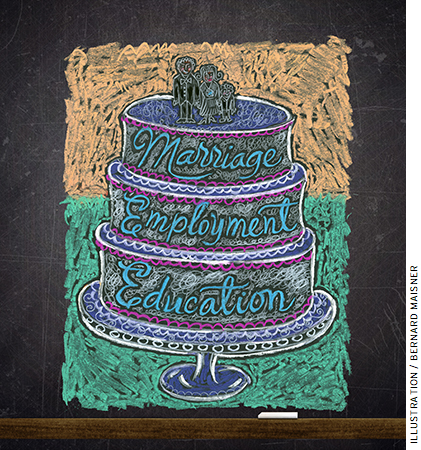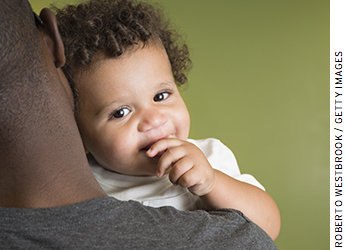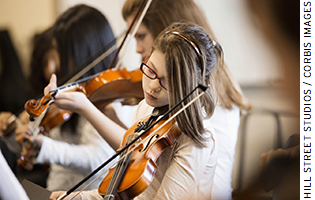This article is part of a new Education Next series on the state of the American family. The full series will appear in our Spring 2015 issue to mark the 50th anniversary of the 1965 release of Daniel Patrick Moynihan’s report “The Negro Family: The Case for National Action” (generally referred to as the Moynihan Report).
 This may seem like a ridiculous question. How can schools possibly persuade more adults to marry? And not have children out of wedlock? Fifty years ago, Daniel Patrick Moynihan himself decided it was inadvisable to offer solutions to problems afflicting the “Negro family.” Since then, our familial challenges have only grown deeper and wider, with 4 in 10 American babies now born to unwed mothers, including a majority of all children born to women in their 20s, and almost one-third of white babies. There are no obvious or easy prescriptions for reversing these trends.
This may seem like a ridiculous question. How can schools possibly persuade more adults to marry? And not have children out of wedlock? Fifty years ago, Daniel Patrick Moynihan himself decided it was inadvisable to offer solutions to problems afflicting the “Negro family.” Since then, our familial challenges have only grown deeper and wider, with 4 in 10 American babies now born to unwed mothers, including a majority of all children born to women in their 20s, and almost one-third of white babies. There are no obvious or easy prescriptions for reversing these trends.
And why put this on the schools? One could argue that reducing teenage pregnancy is a reasonable job for our education system—and that if we could encourage girls to wait until they were in their 20s, and educated, to have babies, they might also wait for marriage. Well, teenage pregnancy rates are down 50 percent from their peak in 1990. High-school graduation rates are up, from 65 percent in the early 1990s to 80 percent today. Yet out-of-wedlock birth rates are as high as ever—we merely pushed early childbearing from the late teens to the early 20s. Now, the young adults who are having babies before marriage haven’t had any contact with the K–12 system for two years or more.
Yet for educators and education policymakers to ignore the issue of marriage seems irresponsible. We tell ourselves that one of the great purposes of education reform is to lift poor children out of poverty. Today’s main strategy is to prepare many more low-income youngsters for college. According to the Pew Economic Mobility Project, 90 percent of low-income children who attain a four-year college degree escape the lowest income quintile as adults, versus just 53 percent of the non–degree holders. Put another way, individuals who grow up in low-income families are almost five times as likely to become low-income adults if they fail to complete a four-year college degree.
The problem, however, is that just 10 to 15 percent of low-income children actually complete a college degree. An analysis by Andrew Kelly of the American Enterprise Institute finds that about one-third of low-income students start college but don’t finish. Kelly argues convincingly that a college degree is a “big payoff, low probability” strategy for economic mobility. Surely it can’t be the only arrow in our quiver.
So what if “college as a springboard to the middle class” isn’t the only strategy? What about “marriage as a springboard to the middle class”? Particularly marriage before childbearing? Or what Isabel Sawhill and Ron Haskins of the Brookings Institution call the “success sequence”: get at least a high school diploma, work full time, and wait till you are at least 21 and married before having children. They estimate that 98 percent of individuals who follow those three norms will not be poor, and almost three-quarters will be solidly middle class. On the flip side, three-quarters of young people who fail to follow any of those norms will be poor, and almost none will be middle class.
Maybe it’s not so ridiculous to ask, What can schools do to encourage young people to follow the success sequence, including putting marriage before children?
“Drifting” into Parenthood
Our first challenge is to understand why so many young people—especially those who are low-income—are choosing to have children before marriage. A related question is why most affluent, well-educated young adults wait till their late 20s or 30s, and for marriage, before having children. Assuming we don’t want to encourage teenage parents to marry, what can we do to encourage teenagers and those in their early 20s to wait until they are older, educated, employed, and married before having children?

This has been the subject of vast debate—and increasingly sophisticated research—for decades. A foundational question is, Are young adults “choosing” to have children, or is it happening by accident, because they are having sex without using birth control? Are they deciding to start a family, or are they “drifting into sex and parenthood,” in the words of Sawhill?
The current consensus is that most young people having children before marriage aren’t exactly doing so on purpose, but they also aren’t trying very hard to prevent it. It’s not that they don’t understand how birth control works, or fail to use it in the heat of the moment (though that’s part of it). Rather, they make a somewhat-conscious decision to stop using birth control once they have been “associating” with someone for a while.
Some of the best work on this subject comes from Johns Hopkins sociologist Kathryn Edin. She and her co-authors spent years living in low-income and working-class Philadelphia and Camden, New Jersey, neighborhoods, where they met and interviewed young parents, white and black. They found that most young people weren’t sad when they learned that they—or their girlfriends—were pregnant; they treated the news with excitement, rather than with regret.
So have the baby, and raise the baby, they did. But didn’t they know they were consigning their children and themselves to a life of hardship? Didn’t they understand that if they were going to “climb the mountain to college”—or even to a decently paying job—doing so with a baby in a stroller would make the ascent that much tougher?
What Edin and her co-authors show is that the young women and men see parenthood as a chance to “start over” and to do something good with their lives, as well as to connect deeply with another human being. “In these decaying, inner-city neighborhoods, motherhood is the primary vocation for young women, and those who strive to do it well are often transformed by the process,” she and Maria Kefalas write. Furthermore, “Children provide the one relationship poor women believe they can count on to last. Men may disappoint them. Friends may betray them. Even kin may withdraw from them. But they staunchly believe that little can destroy the bond between a mother and child.”
Edin and Timothy Nelson pick up this theme: “Fatherhood offers the opportunity to connect with a child—an unsullied version of oneself—in an intensely meaningful way. But fatherhood is also a tool, almost a magic wand that youth…can use to neutralize the ‘negativity’ that surrounds them as they come of age in chaotic and violence-charged neighborhoods like East Camden.”
Unfortunately, and not surprisingly, these hopeful attitudes eventually give way to the grinding reality of daily life. Most of the romantic relationships between the parents fall apart within a few years. The dads desperately want to spend time with their kids—but not with their kids’ mothers—an arrangement that eventually proves untenable. And so another generation of children is raised in poverty, with single mothers doing most of the child care and trying to make ends meet, and fathers having additional babies with other women in a fruitless quest to “start fresh” and “do the right thing.”
What might be done to change this dynamic? Edin (like Sawhill) is a proponent of making low-cost, long-acting birth control available to young people, and there’s good reason to believe that it can reduce unplanned pregnancies significantly. But the most important “intervention,” according to Edin, is hope: a realistic plan for a life trajectory that is more compelling than early motherhood and fatherhood. (William Damon, at Stanford University, calls this “purpose.”) This means, among other things, having meaningful opportunities for higher education and interesting, decently paid work.
Hope, and purpose, are why affluent, well-educated young men and women wait until their late 20s or early 30s to have children. For them, having a baby before finishing their educations or launching their careers is something of a catastrophe—a huge wrench in their plans and aspirations. They would risk missing out on all manner of fun and fulfilling experiences—college, international travel, living in a big city, enjoying the singles life, climbing the ladder—if they were raising a child.
A key issue is motivation. In particular, how can we motivate young women, and particularly young low-income women, to wait until they are older, educated, employed, and married before they have children? The answer? First, help those young women develop strong prospects for interesting, decently paid careers. And second, give those young women access to “marriageable men”—young men who themselves have strong career prospects. So let’s start there.
What Schools Can Do
Schools can boost the education and employment prospects of disadvantaged youth. The push to get many more young people—especially those from challenging backgrounds—“to and through” college is well documented—and well meaning. There’s little doubt that this should remain a major focus of education reform—and when it’s successful, will encourage many more young people to delay childbearing, which increases their odds at getting married before starting a family.

But it need not be our only strategy for helping adolescents find their way to a rewarding, middle-class career and stable family life. High-quality career and technical education (CTE) is another solid pathway to remunerative and satisfying work—jobs that are worth working toward, and thus that can motivate delayed childbearing.
As scholars such as Harvard’s Robert Schwartz and Georgetown’s Anthony Carnevale have shown, “middle skills” jobs remain plentiful and pay well in the U.S. economy—accounting for roughly 30 percent of the jobs likely to be available over the next decade. These are positions that generally require a postsecondary certificate but not a four-year degree, in fields such as health care and information technology. Employers regularly struggle to fill these roles, in large part because of America’s underdeveloped—and often ignored—technical training system. European countries such as Germany, Norway, and the Netherlands prepare between 40 and 70 percent of their young people for technical jobs by the age of 20. Yet in the U.S. we remain obsessed with the four-year college degree; fewer students are concentrating in career and technical education at the high school level in America than they were 20 years ago.
That’s a huge lost opportunity, as gold-standard studies of career academy programs have shown. In this model, students in grades 9–12 enroll in “smaller learning communities,” generally within large comprehensive high schools, which combine academic and technical training. The academies are organized around career clusters and partner directly with local employers. A randomized evaluation by the Manpower Demonstration Research Corporation (MDRC) found significant positive outcomes for academies’ participants, most of whom were low-income, African American, and/or Hispanic. Among the program’s long-term benefits, which were strongest for minority men, were higher earnings, greater hours worked, and stronger attachment to the labor market.
Perhaps most intriguingly, MDRC found that the young men who years earlier had graduated from a career academy were 33 percent more likely to be married, and living with their spouse, than their peers in a control group. Whether that was because the graduates developed skills that helped them form more stable relationships, or became more “marriageable” because of their stronger career prospects, the lesson is clear: work works. As does high-quality CTE.
Of course, it’s not as simple as creating more career academies. Students entering these programs must possess strong math, reading, and writing skills. They also need to be well behaved and willing to work hard. That means that our elementary and middle schools need to help many more students get ready for rigorous programs in high school—academically, socially, and otherwise. It’s not any easier to prepare students for great CTE programs than it is to prepare them for great college-prep programs. Thus the larger education-reform agenda—higher standards, greater accountability, stronger teachers, solid curricula, especially in grades pre-K–8—remains essential.
Schools can also help their students develop “performance character”—drive and prudence in particular. Brookings Institution scholar Richard Reeves explains why these attributes are so essential:
People with drive are able to stick with a task, even when it gets boring or difficult; they work hard and don’t leave a job unfinished. Drive includes not just the ability to work hard (industriousness) but also the ability to overcome setbacks and to keep going (resilience).
Prudent people are able to defer gratification and plan for the future; they can make sacrifices today in order to ensure a better tomorrow. The better developed a person’s character strength of prudence, the less they suffer from what economists call “present bias,” the tendency to underweight future utility. They can both plan for the future and exert self-control in the moment to reach their long-term goals.
Reeves and others point to evidence indicating the importance of drive. For example, the fact that students’ high-school grade-point averages predict college completion better than SAT scores may be one indication that hard work and resilience pay off, even more than talent. The evidence for “prudence” is even stronger, ranging from Walter Mischel’s work on delayed gratification to Angela Duckworth’s findings about the importance of grit and self-control for long-term success.
It stands to reason that young people with the drive to work hard at school and on the job and the prudence to delay childbirth—either by eschewing sex or by making good birth-control decisions—are going to be more likely to climb the ladder to upward mobility, and potentially to marry.
So how can schools teach these skills and habits? The old-fashioned way is, of course, through religion. Catholic schools in particular have long been singled out by social scientists for their strong results in terms of graduation and college-going rates. These strong long-term outcomes—which tend to be much more significant than any short-term test-score gains—likely reflect Catholic schools’ focus on discipline and character as much as their excellent academics. In the early 1980s, James Coleman and his colleagues found that Catholic-school students were significantly more likely to report that their schools’ approach to discipline was “excellent or good” than their public-school peers. Later research by Anthony Bryk confirmed this view with Catholic-school administrators, who were much less likely to report student-behavior problems than their public-school colleagues.

A 2012 study by David Figlio and Jens Ludwig found that Catholic high-school students were less likely to participate in risky behaviors, including teen sexual activity, arrests, and the use of cocaine. They speculated why this might be so. One possibility is the most obvious: Catholic schools put the fear of God into their students. Religious instruction “could affect students’ ‘tastes’ for misbehavior, or increase the perceived costs of misbehavior by defining a number of activities as sins that have eternal consequences.” And of course there is the role of positive peer pressure—by “exposing them to more pro-social peer groups,” particularly by selecting out and/or expelling students more likely to engage in risky behaviors.
The secular, New Age way to teach character is best illustrated by KIPP (Knowledge Is Power Program), which has placed character education at the heart of its “no excuses” ethos. As made famous by Paul Tough’s best-selling book How Children Succeed, many KIPP schools use a “character growth card” to help teachers, students, and parents work together to develop specific character strengths, such as grit, optimism, and curiosity. Some KIPP schools are incorporating mindfulness training and even yoga to help their students build self-control so they can make better choices toward their long-term success.
Don’t Forget the Extracurriculars
There’s one more way schools can help students develop important character strengths, while keeping them off the streets: provide an excellent suite of extracurricular offerings. This might be one secret to Catholic schools’ success; Figlio and Ludwig report that students in Catholic schools “spend more time on homework and extracurricular activities than those in public schools…Private schools may thus reduce delinquency if only because of an ‘incapacitation effect’—teens who are doing homework or running track are not out looking for trouble.”

Extracurricular activities, including athletics, appear to be important for public school students, too; as June Kronholz reported in these pages (“Academic Value of Non-Academics,” features, Winter 2012), studies have long found that disadvantaged students who participate in extracurriculars are less likely to drop out of high school, use tobacco or alcohol, or get pregnant, and are more likely to score well on tests, attend college, and complete college. Granted, it’s hard to tease out the selection bias of these studies; it’s tough to know whether participating in these activities caused teenagers to make better choices, or whether teenagers who made good life choices also chose to participate in sports and other extracurriculars.
But as Kronholz explains, some studies attempt to correct for such bias, and still find compelling outcomes. For instance, research by Columbia University scientist Margo Gardner examined the issue, using “propensity scoring,” and found that the odds of attending college were almost twice as high for students who participated in school-related activities for at least two years; such students were also dramatically more likely to complete college and significantly more likely to vote as adults.
It is therefore counterproductive, if not tragic, that schools serving high concentrations of poor students are less likely to offer extracurricular activities. In an innovative 2009 study, researchers Elizabeth Stearns and Elizabeth J. Glennie at the University of North Carolina scoured yearbooks and state administrative data to determine the number of activities offered, and percentage of students participating, in each high school in North Carolina. High-poverty schools offered fewer activities and showed lower participation rates than their low-poverty peers. It’s hard to know whether that’s due to lack of funding or an obsession with more academic, college-oriented pursuits, but it’s clearly a lost opportunity that could and should be remedied.
Where There Is Hope

So maybe schools should try to address America’s marriage crisis. At the very least, they can help to instill a sense of hope and optimism in their students—by getting them ready for college and/or a satisfying career, by embracing high-quality technical education, and by developing in them character traits like drive and prudence, both via classroom instruction and through extracurricular activities. All of these actions, done well, are almost certain to help push back the average age of childbearing, which will help the next generation do better academically and economically.
Not all of these actions are easy to implement within our traditional public-school system, though, which clearly cannot teach religion but also struggles to enforce high expectations around student behavior. School choice, then, must be an important part of this strategy, because it allows parents and their children to opt into schools, including religious schools, that share their values. Importantly, school choice also avoids the specter of “the system” tracking certain students into certain programs (like technical training). A much better approach is to allow students and families to select into schools and programs that they themselves find compelling.
But will these steps actually lead to a renaissance in marriage? That’s harder to know, and the honest answer is “maybe at the margins.” We may have a better shot at turning around our marriage trends if young people are waiting longer to have children, picking up important skills and work experiences along the way. And those individuals will, on average, be better parents than if they had children as teenagers or early 20-somethings, with few skills under their belts or job prospects on their horizons.
Fixing our marriage problem isn’t a job for schools alone, of course. If we’re serious about getting more people to tie the knot, we’ll also tackle prison reform (to help make more men “marriageable”), wage supports (ditto), and tax reform (to remove marriage penalties). But in the meantime, our schools can help give their graduates a reason to wait to become parents, and possibly put them on a path to saying “I do.”
Michael J. Petrilli is president of the Thomas B. Fordham Institute, a research fellow at the Hoover Institution, and an executive editor of Education Next.
This article appeared in the Spring 2015 issue of Education Next. Suggested citation format:
Petrilli, M.J. (2015). How Can Schools Address America’s Marriage Crisis? Prepare young people for rewarding careers. Education Next, 15(2), 56-62.


